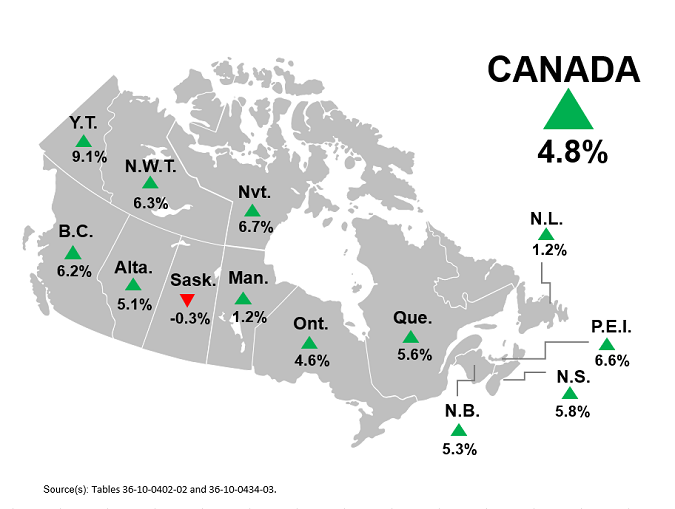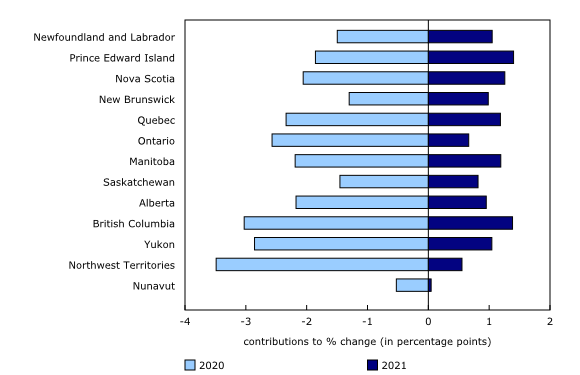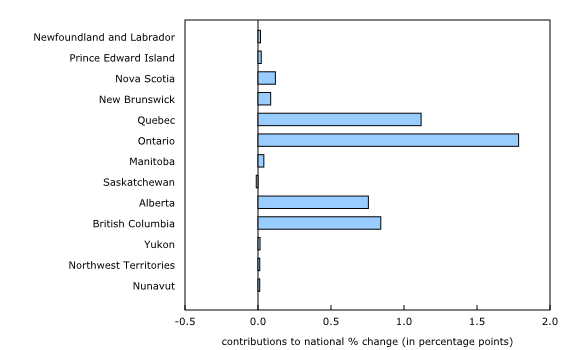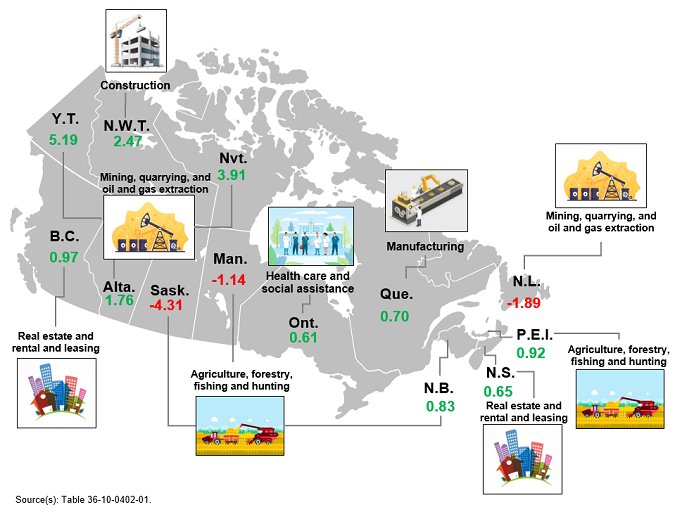Gross domestic product by industry: Provinces and territories, 2021
Released: 2022-05-02
2021
4.8% 
(annual change)
2021
1.2% 
(annual change)
2021
6.6% 
(annual change)
2021
5.8% 
(annual change)
2021
5.3% 
(annual change)
2021
5.6% 
(annual change)
2021
4.6% 
(annual change)
2021
1.2% 
(annual change)
2021
-0.3% 
(annual change)
2021
5.1% 
(annual change)
2021
6.2% 
(annual change)
2021
9.1% 
(annual change)
2021
6.3% 
(annual change)
2021
6.7% 
(annual change)
Rapid recovery from pandemic's economic impacts for most Canadian provinces and territories
Real gross domestic product (GDP) rose in every province and territory except Saskatchewan in 2021, as many sectors of the Canadian economy continued to emerge from significant contractions caused by the COVID-19 pandemic in 2020. In 2021, all levels of government across the country deployed health measures to slow the spread of the coronavirus and its re-emergence throughout the year. Output of client-facing businesses such as restaurants, hotels, museums, movie theatres, airlines and clothing stores was, for the most part, still well below pre-pandemic levels in every jurisdiction.
Size not the only factor in contribution to national percentage change
Contributing most to the increase of 4.8 percentage points at the national level in 2021 was Ontario, which accounted for 1.79 percentage points, owing to its relative size and a rebound to near its 2019 level. Next was Quebec, accounting for 1.12 percentage points of the national growth. Surpassing Alberta's contribution (0.76 percentage points) to total national growth in 2021 was British Columbia (0.84 percentage points). This occurred despite Alberta's solid recovery in oil and gas extraction, thanks to the strength of British Columbia's large real estate sector—as well as severe drought impacting agriculture in the Prairie provinces.
Recovery in 2021 was broad-based, but certain sectors stood apart
The economic recovery in Canadian provinces and territories in 2021 was primarily driven by services-producing industries, which were up in every jurisdiction, while on the goods-producing side, value-added was far more region-dependent.
All components of the public sector (educational services, health care and social assistance, and public administration combined) were up throughout the country in 2021, reflecting a notable turnaround from 2020. Following a year in which health care and social assistance services (such as offices of physicians, dentists and medical and diagnostic laboratories) reduced many of their in-person visits and activities in their establishments in response to the onset of the pandemic, the easing of those same restrictions in 2021 led to a strong rebound in the sector. Health care and social assistance was the single largest contributor to national value-added in 2021, with the highest year-over-year growth coming in Yukon (+10.5%), followed by British Columbia (+10.3%).
In educational services, increases were above the national rate (+6.1%) in Ontario, Quebec and Newfoundland and Labrador. Elementary and secondary schools was the main driver of growth in the educational services sector for all provinces, as the interruptions to in-person and virtual instruction observed in 2021 were not as impactful as in 2020. Meanwhile, public administration was up in all provinces and territories in 2021. Professional, scientific and technical services recovered above its 2019 level nationally, with Ontario (+6.7%) and British Columbia (+8.2%) recovering from their only declines in the past 11 years (in the case of Ontario) and 12 years (in the case of British Columbia) in 2020, and Quebec (+8.5%) registering a sixth consecutive year of growth.
Service sectors reliant on in-person customers regained ground lost in the first year of the pandemic
In 2021, output of retail trade was above 2019 levels in every province and territory. Leading the growth was a rebound in motor vehicle and parts dealers for all jurisdictions except the Northwest Territories.
Accommodation and food services also saw increased value-added across the country, as the roll-out of COVID-19 vaccines allowed for the easing of restrictions on indoor dining and an increase in the demand for lodging. However, the sector as a whole remained well below 2019 levels for all jurisdictions. The transportation and warehousing sector regained a small portion of the losses from 2020, with further declines in air transportation being more than offset by an increase in truck transportation.
Real estate and rental and leasing, and finance and insurance, both having expanded in 2020, increased in all provinces in 2021. As was the case in 2020, historically low interest rates and the ability to work remotely in 2021 helped support a robust resale housing market as shown by the surge of activity at the offices of real estate agents and brokers.
Construction sector contributed to growth in most jurisdictions
The high demand for housing in 2021 was mirrored in residential building construction, for which some jurisdictions saw the highest GDP growth rates in two decades or more. In Prince Edward Island, the construction sector was up 10.2%, with two-thirds of that increase coming from residential construction. Increased residential construction activity in Nova Scotia, combined with a new solar garden project that contributed to electric power engineering construction (+62.8%), helped the construction sector lead growth for the goods-producing industries. Following three years of decline, construction grew in Alberta, with an increase in residential building construction (+16.8%) and renewable energy projects which contributed to electric power engineering construction (+55.3%).
Agriculture's gross domestic product in Western provinces strongly impacted by extreme weather…
The record heat and drought conditions caused production to plummet in Western provinces in 2021. In Saskatchewan, the agriculture, forestry, fishing and hunting sector suffered its most significant decline since the series started in 1997. The drop in the agricultural sector was precipitated by a 47.0% decline in crop production under severe drought conditions. The extreme drought in Manitoba yielded not only a 25.4% cut in crop production, but also a 16.7% decline in electric power generation, transmission and distribution which relies heavily on hydroelectric power. In the meantime, more favourable conditions in Ontario and Quebec resulted in increased yields.
...while in Atlantic Canada, fishing, hunting and trapping benefited from high prices and demand for seafood products
In Prince Edward Island, increased seafood prices and ideal growing conditions in 2021 resulted in agriculture, forestry, fishing and hunting enjoying its strongest gain since 2002. Fishing, hunting and trapping increased 23.8%, with a strong yield for potatoes supporting crop production (except cannabis, greenhouse, nursery and floriculture production) growth (+18.4%). As with the other Atlantic provinces, New Brunswick's agriculture, forestry, fishing and hunting sector (+23.5%) was bolstered by favourable weather conditions, with all subsectors in the province recording gains.
Manufacturing contributed to growth across almost all provinces and territories, despite disruptions to the supply chain
Machinery manufacturing and food manufacturing grew in almost all provinces and territories in 2021. Growth in these provinces and territories more than offset the declines in transportation equipment manufacturing and electrical equipment, appliance and component manufacturing brought about in part by the shortage of available semiconductor chips. Manufacturing in Quebec (+5.4%) started to recover in 2021, but did not reach its pre-pandemic level. Manufacturing output also increased in Ontario, with 16 of 19 subsectors growing, however, transportation equipment manufacturing fell 7.3%, largely driven down by motor vehicle manufacturing (-19.5%). In British Columbia, manufacturing increased 4.2%, with 12 of 19 subsectors reporting gains. Wood product manufacturing was up 9.0% in British Columbia, with high demand for residential building construction across North America.
Activities related to oil and gas extraction rebound in Western provinces
The mining, quarrying, and oil and gas extraction sector also contributed to national growth on the strength of higher oil and gas production from Western producing provinces in 2021. Higher energy prices spurred a recovery in Alberta's oil and gas extraction (+6.3%), led by oil sands extraction as global demand for oil rebounded strongly. Support activities for oil and gas extraction increased following two years of decline. However, oil and gas extraction dropped 9.7% in Newfoundland and Labrador on lower output from the province's offshore projects.
In the territories, the mining sector occupies a prominent place in economic activity
Gold and silver mining showed strong growth in Yukon (+35.8%) and Nunavut (+27.0%) in 2021. Diamond mining rose 12.2% in the Northwest Territories with a return to full operations at the Ekati mine in early 2021. Support activities for mining also jumped in response to higher commodity prices and mined output in each of the territories.
Sustainable development goals
On January 1, 2016, the world officially began implementation of the 2030 Agenda for Sustainable Development—the United Nations' transformative plan of action that addresses urgent global challenges over the next 15 years. The plan is based on 17 specific sustainable development goals.
The release on real gross domestic product by industry for provinces and territories is an example of how Statistics Canada supports the reporting on the Global Goals for Sustainable Development. This release will be used in helping to measure the following goal:

Note to readers
The provincial and territorial gross domestic product (GDP) by industry data at basic prices are chained volume estimates with 2012 as their reference year. This means data for each industry and aggregate are obtained from a chained volume index multiplied by the industry's gross value added in 2012.
Percentage changes for GDP by industry are calculated using volume measures, that is, adjusted for price variations.
The Economics accounts statistics portal and the data visualization product Gross domestic product (GDP) by industry, provinces and territories: Interactive tool also display the latest available results.
Statistics Canada compiles "Contributions to Percentage Change" and "Contribution to National Percentage Change" figures, which provide users with additional dimensions for their analysis by delineating, respectively, how industries in the provinces or territories contribute to their own relative total economy and in turn how provinces and territories contribute to the real growth of the Canadian economy.
For more information on GDP, see the video "What is Gross Domestic Product (GDP)?"
Revisions
Estimates of provincial and territorial GDP by industry for 2021 are included with this release. No revisions have been made to estimates for previous years. Revised estimates of provincial–territorial GDP by industry for 2019 to 2021 will be published in November 2022 with the incorporation of the new benchmark supply and use tables for reference year 2019.
Contact information
For more information, or to enquire about the concepts, methods or data quality of this release, contact us (toll-free 1-800-263-1136; 514-283-8300; infostats@statcan.gc.ca) or Media Relations (statcan.mediahotline-ligneinfomedias.statcan@statcan.gc.ca).
- Date modified:




